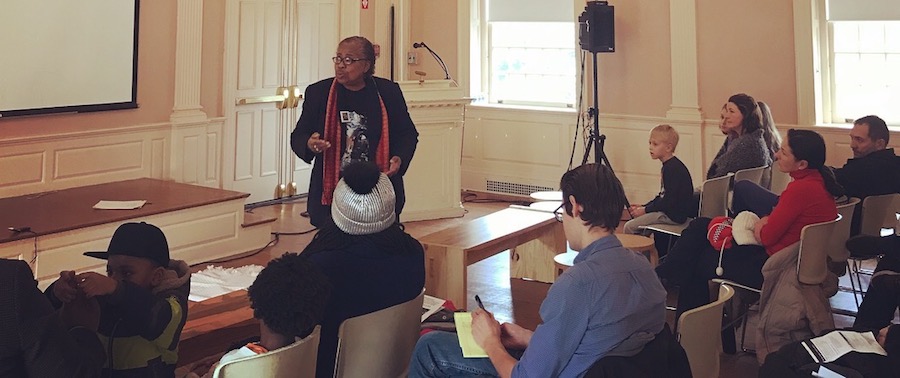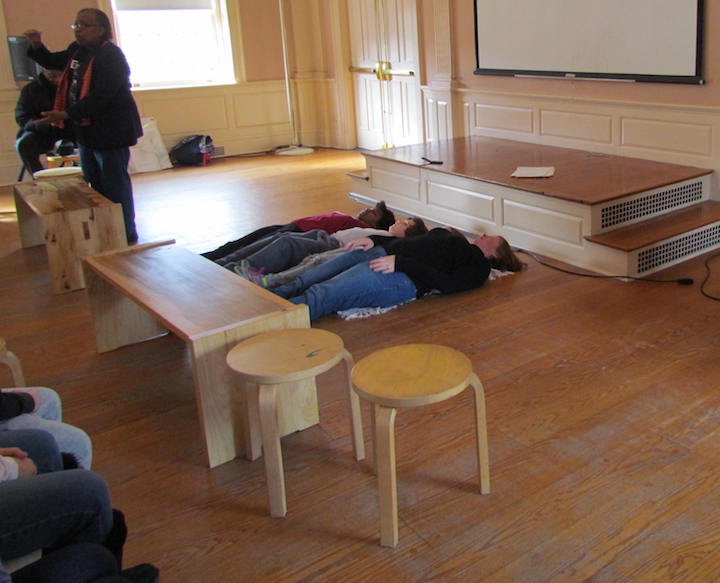
Joy Donaldson: “What were my people given? A form of Christianity—not true Christianity as we know it today." New Haven Museum Photo.
Storyteller Joy Donaldson spread a large, white blanket across the floor of the New Haven Museum’s ballroom before starting her hour-long talk. It was an innocuous-looking knitted thing, woolen-seeming with a big rag fringe along its four edges. But it was soon to be a vibrant part of the 22nd Annual Dr. Martin Luther King, Jr. Legacy of Environmental and Social Justice celebration. Other activities included day-long performances and a poetry slam at the Yale Peabody Museum of Natural History.
“Can I get three volunteers?” Donaldson asked. One young girl stepped forward, puffing her cheeks out into a goofy, scrunched-faced, puckering smile as the audience’s gaze concentrated half-comfortably on her.
“I’m going to ask you to lay down, here, on your back,” Donaldson said. The participant did, setting her head towards the stage and offering her feet to the crowd. Two more volunteers followed suit: one child and one adult.
“You know what,” Donaldson mused, “they’re so small! I need another volunteer.” She shaped and scooched the four bodies along the floor, coaching and coaxing them aloud. “Closer, closer, closer! Arms to the sides! Oh, no—you can’t lie on your side.”
She stood back, admiring her work, at last satisfied. “Now: That’s how you travel for three months. At the bottom of a ship. There’s only 36 inches height at the bottom of a slave ship. You were allowed to go up on deck, one time a day if the weather was good. But that’s where you stayed until you died and they threw you overboard.”
She dismissed the participants back to their seats. “Thank you,” she said. “Thank you so much.”

“Closer, closer, closer! Arms to the sides! Oh, no—you can’t lie on your side.” Amy Durbin Photo.
One of three presenters at the New Haven Museum for a morning and afternoon of MLK Day storytelling, Donaldson outlined the legacy of African-American slavery in the United States up to the Montgomery Bus Boycott. (The Civil Rights Movement onwards was the topic of her 2 p.m. presentation.) Speaking to both children and their parents, she described how Africans were not the first choice for forced labor in the New World, detailing how indentured servants could too easily disguise themselves and escape into the general population, how indigenous peoples knew the land too well.
Donaldson pointed out that the enslavement of Africans in the colonies “was the first time that servitude was based on color,” and that the colonists broke with all historical precedent for how to treat enslaved persons. She enumerated a litany of abuses: there was no chance to work your way to freedom, your children were not yours, your language was forfeit, drums and musical equipment was illegal, you were not allowed to keep your religion.
“What were my people given? A form of Christianity—not true Christianity as we know it today,” she said. “They could hear ‘Slave! Obey your master!’ straight out of the Bible, but they kind of forgot the part that said ‘Love your slave like yourself!’”
Donaldson wove the corresponding songs of resistance into the talk, starting with numbers that were instantly recognizable to the majority grade-school attendees. When she delivered the first few stanzas of “Them bones, them bones/Them dry bones/Hear the Word of the Lord,” the kids in the room compulsively began hum and mumble along. They appeared enthusiastic to have partly known this song, thrilled to hear their anatomy lesson estranged or defamiliarized by its original historical context.
She transitioned in to the songs of daily life, singing: “There’s a meeting here tonight,” “Let us cheer the weary traveler,” and “Momma, is massa’ gonna’ sell us tomorrow?” In the case of the latter, Donaldson repeated the questioning refrain at increasingly higher pitches, letting her voice become strained, more heartbroken—ending in a dejected, wavering, trailing “Yes, yes, yes! Oh, watch and pray.”
Donaldson pulled no punches. When she mentioned in passing that the “sharks always followed the slave ships” because they knew they could find “regular meals,” an indignant, offended tremor went through the students’ swinging knees. The bobbing, fidgeting heads looked up with dry-eyed, quiet outrage—apparently wise beyond its years.
With grandparents in North Carolina, Donaldson experienced Jim Crow first-hand. It chafed on her free-speaking sensibilities, “growing up in Waterbury, Conn.” She “was used to going where I wanted to go, saying what I wanted to say.” She smiled mischievously at this recollection of her youthful troublemaking, leaning forward on a shift in her weight.
Donaldson told her most vivid brushes with white hatred. She publically remembered a segregated ice cream bar on a hot August day: kids seated at stools behind pane glass, in cool air conditioning.
“I took off for that ice cream bar and my mother snatched me so hard and said: ‘Where do you think you are going? Those ice creams are not for you!’ Sixty-five years later, it is still one of my most poignant memories of being born with brown skin and not white skin.”
Before concluding her presentation, Donaldson had to poll the audience: Was Rosa Parks arrested in the front of the bus or the back of the bus? The crowd was split; many abstained.
“Those of you who say ‘the back of the bus’ are absolutely correct.” This struck the room like a lightning bolt. Donaldson veered offstage to grab a prop—a “coloreds” sign on white poster paper.
“This is a lesson you have to know,” she said, placing the sign on the ballroom floor and transforming all the seats into imaginary bus benches.
“If you waited at the bus stop, you had to put your money in the coin box at the front, and then you had to get off the bus and go in the back side,” she said. “You had to hope that the bus didn’t take off with your money.”
“Now, if the front was filled,” she went on, “the people in the back had to get up and go back farther. The whole row of seats had to be emptied out.” She paused, here, to shoo the audience members immediately behind her “coloreds” sign out of their chairs, sitting down in one herself—the better to emphasize the level of male, Euro-American privilege she was about to drop.
“If you were white and on a bus, you didn’t have to see a black person to the … left of you, or the right of you. One man was going to commandeer that whole row of seats.”
The standing and re-seated listeners slowly frowned. Realization buzzed and muttered. Rosa Parks was sitting right where she ought to have been if her bus was at normal operating capacity: there was nothing overtly disobedient, or flagrantly malicious about her gesture. It was entirely reasonable, even by the standards of the South.
“The textbooks up until recently only showed her up in the front of the bus,” Donaldson said, adding that the editors who published these deceptive documentary photographs were based out of Texas. “So, I had to teach a whole generation of teachers that those textbooks were wrong.”
She turned back to her audience members still standing, still spellbound by the specter of apartheid authority Donaldson had resurrected with her roleplay.
“You guys can come and sit down again if you wanted to.”